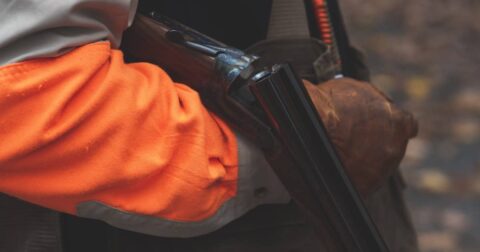News
Sentient Impact Report 2025
Policy•1 min read
Perspective
Many of the deregulations enacted by President Trump prioritize the interests of hunters, property owners, and the fossil fuel industry over the health and well-being of animals and their ecosystems.


Words by Elizabeth Wanaselja
The sun rises over Denali National Park and Preserve in southern Alaska. A black bear emerges from her gloomy den, lethargic after months spent in hibernation without food or water. The winter has made her into a mother. Behind her trail two spritely cubs ready to explore their bright and curious new world. Without warning, three shots ricochet off the trees and, within seconds, mother and cubs collapse onto the freshly thawed earth. As their last warm breaths dance skyward, two hunters emerge from their perch, wide-eyed and laughing.
This is preservation in the Trump era.
In an effort to expand hunting rights, the Trump Administration in July of 2020 overturned regulations previously imposed by the National Parks Service that prohibited certain kinds of hunting and trapping methods from being used in Alaskan national preserves. It is now legal to kill black bears, wolves, and coyotes—including their cubs and pups—at their dens. Additionally, hunters can now kill swimming caribou, use dogs to hunt black bears, and bait bears using food like doughnuts. This deregulation, by legitimizing a range of once-banned hunting practices, increases the vulnerability of several animal species. Reviving hunting practices such as these exacerbates the steep decline in biodiversity already underway and raises questions surrounding what constitutes humane treatment of wild animals.
In July of 2019, the Administration expanded the lethal means by which Canada Goose populations may be controlled. The regulatory change is based on the recommendations of a 2005 impact statement, completed under the Bush Administration, from the Fish and Wildlife Service (FWS). The impact statement proposes lethal means of goose population management to protect the personal property of and prevent injury to humans, protect agricultural crops, and appease a host of other vague concerns. This deregulatory action by the current Administration legalizes the destruction of goose eggs and nests at any time of the year and enables homeowners, property managers, and farmers to easily apply for permits to capture and cull both goslings and adult geese. Canada Geese are known to play important roles in seed dispersal and soil enrichment; taking lethal population control measures is not only fatal for individual birds but harmful to the ecosystems to which they contribute. Considering that avian contraceptives provide a readily-available humane alternative, using lethal means as a damage control measure is unnecessary.
In August of 2019, the Administration revised the Endangered Species Act to supposedly both ease the regulatory burden of listing threatened and endangered species and promote transparency in the decision-making process regarding how species are classified. “Threatened species”—plants and animal species that are likely to become endangered in the “foreseeable future”—formerly received the same blanket protections, including bans on killing, as endangered species. Now, protections for threatened species are imposed on a case-by-case basis by the FWS. Additionally, the phrase “foreseeable future” is now constrained to mean “only so far into the future as the [FWS] can reasonably determine that both the future threats and the species’ responses to those threats are likely”—a definition change that conservation scientists argue is enabling the Administration to disregard climate change’s lasting ramifications on species’ survival. With already over 30,000 threatened species globally, relaxing their protections is likely only accelerating biodiversity loss. These revisions may indeed increase regulatory simplicity, but they also jeopardize the survival of tens of thousands of species.
The Trump Administration finalized deregulations in February and August of this year to open up once-protected land within Utah national monuments and in the Arctic National Wildlife Refuge for mining and drilling, in an attempt to bolster the domestic production of fossil fuels. Mining and drilling operations fragment undeveloped land with expansive infrastructure, while the leaching of fossil fuels from these operations degrades the land, releases toxic chemicals like benzene and formaldehyde into the air, and pollutes waterways. Fossil fuel extraction hinders normal nesting, breeding, and migratory patterns by disrupting the critical habitats of the species that occupy these lands. These deregulations prioritize the economic interests of the fossil fuel industry over the needs of living animals.
Nine million acres of the Sage Grouse’s critical habitat was slashed in March of 2019, in what was largely seen as an attempt by the Trump Administration to promote oil drilling in the Northwest. The Sage Grouse, an iconic rangeland bird that occupies the sagebrush landscape in the western U.S., was dwindling in numbers until the National Resources Conservation Service launched a conservation initiative in 2010. The conservation effort’s success helped the Sage Grouse to evade endangered species status. Reducing the habitat of the Sage Grouse affects the birds directly and also indirectly impacts approximately 350 additional species, including deer, elk, and eagles, who share the same ecosystem. Government-enabled exploitation of the Northwest’s residual fossil fuel reserves is imperiling hundreds of species.
Many of the deregulations enacted in the Trump era blatantly prioritize the interests of hunters, property owners, and the fossil fuel industry over the health and well-being of animals and their ecosystems. Stripped of their protections and habitats, vulnerable animals are under insurmountable pressure to adapt or perish. For increasing numbers of animals, there is no safe place. Even predators’ dens—once unassailable hollows providing welcome respite—are now targets. Humans have immense power to either protect or exploit animals; it’s time to elect government officials who prioritize the former and eschew the latter.